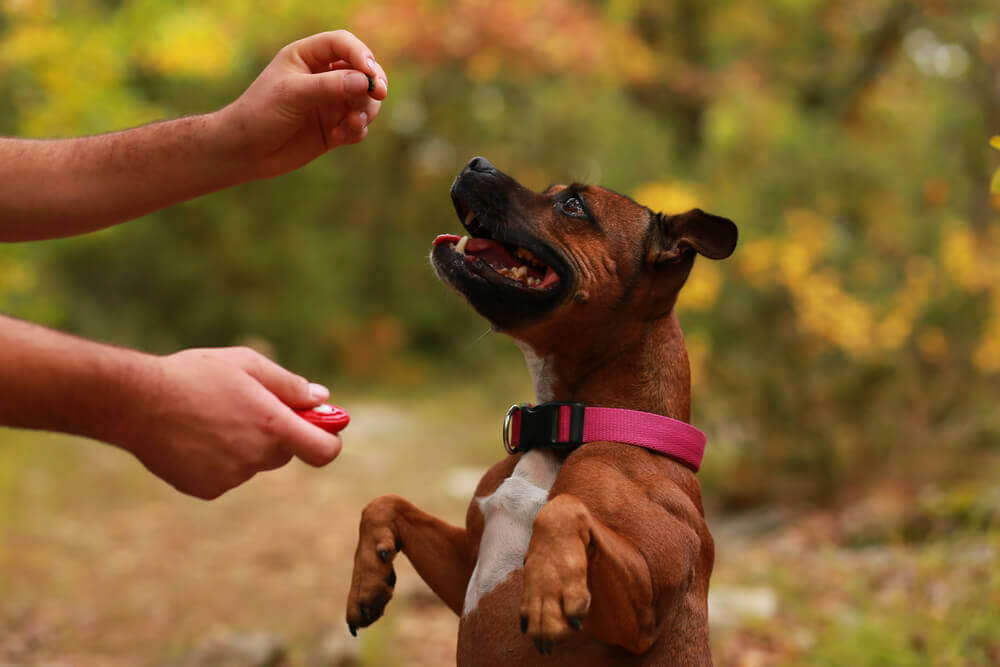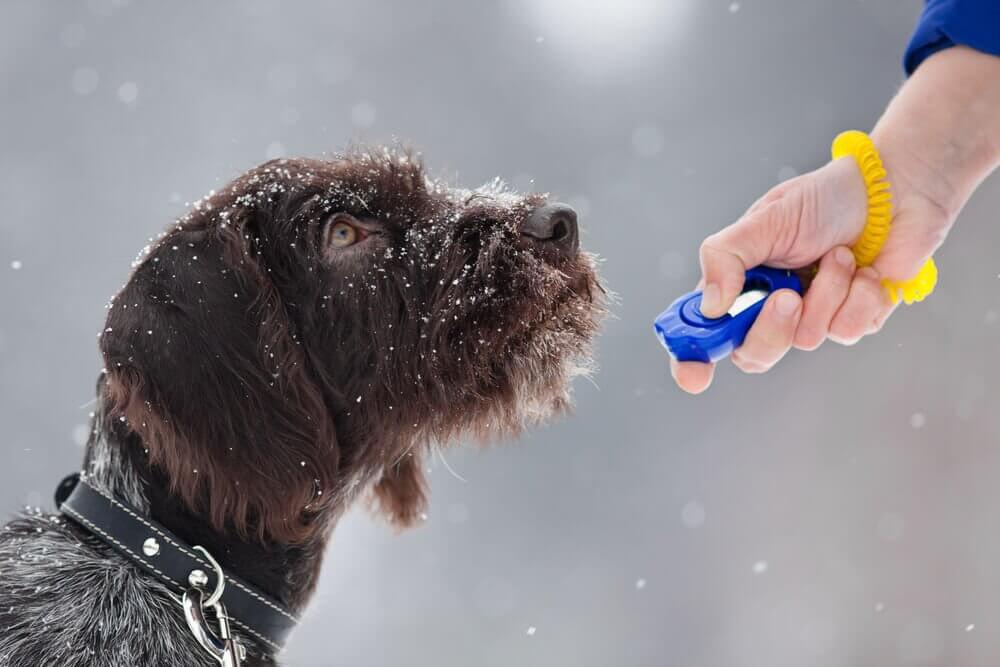Clicker Training Method: What Is It and How to Implement It

In the world of pet training, there are some new methods coming out that can help you reach your training goals! One of them is the clicker training method, a useful tool in animal training. We’ll tell you what is it and how it works in today’s article.
What is the clicker training method?
The clicker training method conditions the animal to make an association between two stimuli. How? Firstly, your pet will associate a neutral stimulus, the sound of the clicker, with something positive, such as a treat.
Therefore, the formula will be NS + US (Neutral Stimulus plus Unconditioned Stimulus). To start out, you’ll just repeat this several times. Then, the animal will start to understand that when he hears the click, he’ll get a treat. Pavlov created this method of conditioning. It’s been shown to be very useful when it comes to pets and their training.
A clicker is a small plastic device with a button or metal tongue that emits clicks when pressed. However, for this to work, you have to know the right way to use it.
How to use the clicker method

To implement the clicker training method, there are a series of steps you need to follow.
Learn to use it
One of the great challenges when training a dog with a clicker is knowing exactly when to use it in order for the NS + US to work. You need to time it to coincide with the exact moment when your pet is following a command.
Therefore, clicking will tell your dog that a reward is coming. He will also immediately relate it to something he has done well. Ultimately, this is much more effective than phrases like “good boy.”
Practice
Of course, just the fact that you know how to use a clicker doesn’t mean that your pet will automatically understand. Here’s how to use it. Take a treat in one hand and the clicker in the other. Press the clicker. Then, when your dog turns towards the sound, give him a treat.
At first, your dog likely won’t understand or even turn towards the clicker sound. However, with time, he’ll be able to relate the sound to the prize.
Find a quiet place
For this method to be effective, you should practice in a room with no distractions. Then, as your pet learns to relate the clicker to the rewards, it will be easier to use the training outside or in a noisier place.
Do it step by step

There’s no better method of learning than positive reinforcement. However, if you also put this into practice in small doses, it will be even more effective. For example, if you want to teach your dog the order “lie down” you can click each time she shows signs of starting to lie down.
Therefore, if you see that your animal is making steps towards complying with the order, click and give her a small treat. Then, continue to click and give treats for each movement towards complying, until the dog carries out the full action. This is known as ‘shaping’ a new behavior.
Consider the verbal order
When choosing a verbal command for your dog, look for a short and easy-to-understand word. In that way, it’ll be easier for your dog to understand and obey. Once you come up with the word, follow the process of click and reward until it’s no longer necessary.
Although many people have claimed that the clicker training method isn’t an example of positive reinforcement in pet training, the truth is that it has led to very good results. In addition to that, it doesn’t hurt the animal’s mental health in any way. Give it a try and you’ll see how much easier the training will be!
In the world of pet training, there are some new methods coming out that can help you reach your training goals! One of them is the clicker training method, a useful tool in animal training. We’ll tell you what is it and how it works in today’s article.
What is the clicker training method?
The clicker training method conditions the animal to make an association between two stimuli. How? Firstly, your pet will associate a neutral stimulus, the sound of the clicker, with something positive, such as a treat.
Therefore, the formula will be NS + US (Neutral Stimulus plus Unconditioned Stimulus). To start out, you’ll just repeat this several times. Then, the animal will start to understand that when he hears the click, he’ll get a treat. Pavlov created this method of conditioning. It’s been shown to be very useful when it comes to pets and their training.
A clicker is a small plastic device with a button or metal tongue that emits clicks when pressed. However, for this to work, you have to know the right way to use it.
How to use the clicker method

To implement the clicker training method, there are a series of steps you need to follow.
Learn to use it
One of the great challenges when training a dog with a clicker is knowing exactly when to use it in order for the NS + US to work. You need to time it to coincide with the exact moment when your pet is following a command.
Therefore, clicking will tell your dog that a reward is coming. He will also immediately relate it to something he has done well. Ultimately, this is much more effective than phrases like “good boy.”
Practice
Of course, just the fact that you know how to use a clicker doesn’t mean that your pet will automatically understand. Here’s how to use it. Take a treat in one hand and the clicker in the other. Press the clicker. Then, when your dog turns towards the sound, give him a treat.
At first, your dog likely won’t understand or even turn towards the clicker sound. However, with time, he’ll be able to relate the sound to the prize.
Find a quiet place
For this method to be effective, you should practice in a room with no distractions. Then, as your pet learns to relate the clicker to the rewards, it will be easier to use the training outside or in a noisier place.
Do it step by step

There’s no better method of learning than positive reinforcement. However, if you also put this into practice in small doses, it will be even more effective. For example, if you want to teach your dog the order “lie down” you can click each time she shows signs of starting to lie down.
Therefore, if you see that your animal is making steps towards complying with the order, click and give her a small treat. Then, continue to click and give treats for each movement towards complying, until the dog carries out the full action. This is known as ‘shaping’ a new behavior.
Consider the verbal order
When choosing a verbal command for your dog, look for a short and easy-to-understand word. In that way, it’ll be easier for your dog to understand and obey. Once you come up with the word, follow the process of click and reward until it’s no longer necessary.
Although many people have claimed that the clicker training method isn’t an example of positive reinforcement in pet training, the truth is that it has led to very good results. In addition to that, it doesn’t hurt the animal’s mental health in any way. Give it a try and you’ll see how much easier the training will be!
All cited sources were thoroughly reviewed by our team to ensure their quality, reliability, currency, and validity. The bibliography of this article was considered reliable and of academic or scientific accuracy.
- Fugazza C, Miklósi Á. Should old dog trainers learn new tricks? The efficiency of the Do as I do method and shaping/clicker training method to train dogs. Appl Anim Behav Sci. 2014;
- Feng LC, Hodgens NH, Woodhead JK, Howell TJ, Bennett PC. Is clicker training (Clicker + food) better than food-only training for novice companion dogs and their owners? Appl Anim Behav Sci. 2018;
This text is provided for informational purposes only and does not replace consultation with a professional. If in doubt, consult your specialist.








